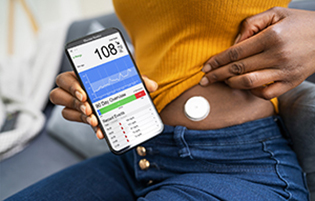What is Type 1 Diabetes?
Type 1 diabetes is one of three main types of diabetes. Type 1 diabetes is an autoimmune condition, which means that your own body makes antibodies against the cells that are responsible for making insulin (these are the beta cells of the pancreatic islets of Langerhans). Eventually, your immune system destroys your own beta cells. People with type 1 diabetes need to take insulin for the rest of their lives because a person cannot live without insulin. Type 1 diabetes makes up just over 5% of all diagnosed cases of diabetes in the U.S.
What Causes Type 1 Diabetes and Who Is at Risk?
Risk factors for type 1 diabetes can include:
- Family history
- Genetics
- Geography
- Age
Type 1 diabetes used to be called “juvenile-onset” diabetes because people thought it affected only children and adolescents. We know now that type 1 diabetes can occur at any age, but it tends to be more aggressive in young people, meaning there are more antibodies destroying those beta cells and doing so more quickly. It is still quite unusual to see type 1 diabetes in infants or very young children.
Other than age, there are different factors that put people at higher risk for type 1 diabetes. There are specific genes that increase the chance of developing type 1 diabetes. This means that if family members have the disease (type 1 diabetes), there is a higher chance that you may have it one day as well. It is clear that genes alone don’t result in the disease, though. Viruses and other environmental factors may be partly responsible, and factors such as geography may have an influence, but it is uncertain.
What Are the Symptoms of Type 1 Diabetes?
Type 1 diabetes has various signs and symptoms. You may not experience all at once and they can appear quite suddenly. Signs and symptoms include:
- Increased thirst
- Increased urination (due to the high blood sugar, which passes through the kidneys to increase volume of urine)
- Feeling very hungry
- Feeling tired, fatigue and weakness
- Feelings of irritability and other mood changes
- Losing weight without trying (people with diabetes are unable to absorb and use the energy from sugar in the blood)
- Blurred vision
How Is Type 1 Diabetes Diagnosed?
Diabetes can be diagnosed by a health care professional based on a person’s symptoms and a blood test.
The specific diagnosis of type 1 diabetes is made based on your risk factors (such as age) and further blood tests that check for the autoantibodies that destroy the insulin-producing cells in the body.
Find endocrine care in your area.
How Is Type 1 Diabetes Treated?
People are usually diagnosed with type 1 diabetes once they have symptoms, which means most or all of the insulin-producing cells are destroyed. As a result, it is often too late to prevent the disease. People with type 1 diabetes need to use insulin for the rest of their lives. While many scientists have been working on it for decades, currently there is no cure for type 1 diabetes.
There are different ways to deliver insulin. Managing type 1 diabetes focuses on figuring out which way is best for keeping your blood glucose levels close to normal, without causing low blood sugar episodes (hypoglycemia). This may involve trial and error. The most effective and common ways of delivering insulin are:
- Multiple daily insulin injections. These involve injecting a basal insulin (glargine U100, glargine U300, determir, or degludec) that make sure your blood glucose remains at appropriate levels overnight and during fasting. People will also inject rapid insulin (insulin LisPro, aspart, and glulisine). The rapid-acting analogs ensure that blood glucose levels stay within normal range following meals.
- People are taught to count the carbohydrate content of their meals in order to match that with the rapid-acting insulin, so that larger meals are controlled by higher amounts of insulin.
- Continuous insulin infusions. Insulin pumps can be worn externally and push insulin under your skin through a skinny plastic tube. Similar to manual injections, the system mimics the human body’s release of insulin. The pump delivers a low and continuous (“basal”) rate of rapid insulin to maintain blood glucose levels overnight and before meals. It also uses additional bursts (“bolus”) of insulin again to cover each meal.
- The exact amount and frequency of insulin deliveries can be programmed. People usually change the infusion site every three days.
- One advantage of the insulin pump is that it can be paired with continuous glucose monitoring (CGM) systems, which are like sensors that are placed on the skin and can read glucose levels in the peritoneal fluid frequently (similar to the glucose in the blood). This creates a feedback loop that allows the pump to adjust the amount of insulin that is injected based on the ongoing results from the blood tests. The paired devices essentially create a closed-hybrid loop and allow people to keep track of their condition.
While much progress has been made into making insulin delivery as painless and convenient as possible, it still takes an injection through the skin.




